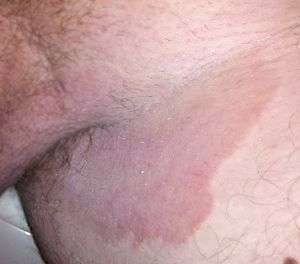Tinea cruris
Tinea cruris is a dermatophyte, a type of fungal infection of the groin region in either sex,[3] though more often seen in males.
| Tinea cruris | |
|---|---|
| Other names | Eczema marginatum, crotch itch, crotch rot, Dhobi itch, gym itch, jock itch, jock rot, scrot rot[1][2]:303 |
 | |
| Tinea cruris on the groin of a man | |
| Specialty | Dermatology |
Signs and symptoms
This condition is most clearly identified by the ring like rash which forms. It is typically a red or brown irritated patch of skin with clear rings. The infection causes itching or a burning sensation in the area which is affected. Most likely originating from the groin, thigh skin folds or anus. Infection may involve the inner thighs and genital areas, as well as extending back to the perineum and perianal areas, and the rash can spread to any part of the body and is considered highly contagious.
Affected areas may appear reddish, tan, or brown, with flaking, rippling, peeling, iridescence, or cracking skin.[4]
The acute infection begins with an area in the groin fold about a half-inch across, usually on both sides. The area may enlarge, and other sores may develop. The rash has sharply defined borders that may blister and ooze.[5]
Tinea cruris has similar symptoms to inverse psoriasis.
Causes
.jpg)
Opportunistic infections (infections that are caused by a diminished immune system) are frequent. Fungus from an athlete's foot infection can spread to the groin through clothing. Tight, restrictive clothing, such as jockstraps, traps heat and moisture, providing an ideal environment for the fungus.[6]
The type of fungus involved is usually Trichophyton rubrum. Some other contributing fungi are Trichophyton mentagrophytes and Epidermophyton floccosum.
Diagnosis
Tinea cruris is similar to candidal intertrigo, which is an infection of the skin by Candida albicans. The latter is more specifically located between intertriginous folds of adjacent skin, which can be present in the groin or scrotum, and be indistinguishable from fungal infections caused by tinea. However, candidal infections tend to both appear, and with treatment, disappear more quickly.[2]:309
Prevention
Medical professionals recommend a preventive approach of stopping fungus before it occurs. Prevention is preferable over a reactive treatment approach. The preventive approach involves removing heat and moisture from the groin area.[7]
Treatment
Tinea cruris is best treated with topical antifungal medications of the allylamine or azole type.[8] Studies suggest that allylamines (naftifine and terbinafine) are a quicker but more expensive form of treatment compared to azoles (clotrimazole, econazole, ketoconazole, oxiconazole, miconazole, sulconazole).[8]
The benefits of the use of topical steroids in addition to an antifungal is unclear.[9] There might be a greater cure rate but no guidelines currently recommend its addition.[9] The effect of Whitfield's ointment is also unclear.[9]
References
- Rapini, R. P.; Bolognia, J. L.; Jorizzo, J. L. (2007). Dermatology. St. Louis: Mosby. ISBN 978-1-4160-2999-1.
- James, W. D.; Berger, T. G.; et al. (2006). Andrews' Diseases of the Skin: Clinical Dermatology. Saunders Elsevier. ISBN 0-7216-2921-0.
- "Tinea Cruris in Women: Bothersome but Treatable". U.S. Pharmacist. 30 (8): 13–17. 2005.
- "Jock itch". NYU Langone Medical Center. Archived from the original on 2007-10-13.
- "Jock itch". MedlinePlus. NLM / NIH.
- "Causes of Jock Itch". Retrieved 2013-01-06.
- "Tinea Cruris Treatment & Management: Medical Care, Diet". 2018-02-22. Cite journal requires
|journal=(help) - Nadalo, D.; Montoya, C.; Hunter-Smith, D. (2006). "What is the best way to treat tinea cruris?". The Journal of Family Practice. 55 (3): 256–258. PMID 16510062.
- El-Gohary, M; van Zuuren, EJ; Fedorowicz, Z; Burgess, H; Doney, L; Stuart, B; Moore, M; Little, P (Aug 4, 2014). "Topical antifungal treatments for tinea cruris and tinea corporis". The Cochrane Database of Systematic Reviews. 8 (8): CD009992. doi:10.1002/14651858.CD009992.pub2. PMID 25090020.
External links
| Classification | |
|---|---|
| External resources |
- eMedicineHealth.com
- MayoClinic.com, jock itch.
- Jock Itch / Tinea Cruris Pictures (Hardin MD Super Site Samples)
- Genekeyes.com, how to Prevent Jock Itch with Rubbing Alcohol.